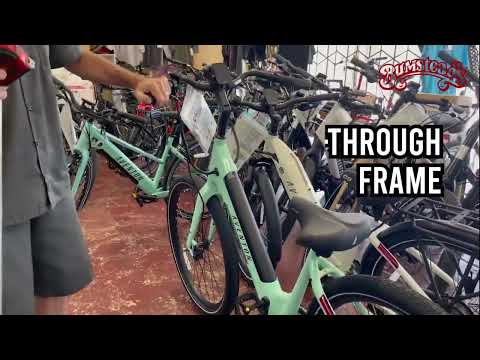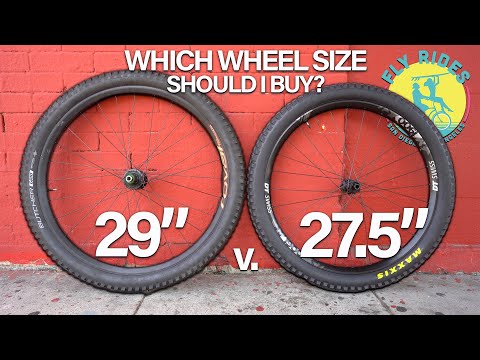Wheel size plays a big role in how an e-bike performs. Many riders wonder if it really matters when picking an electric bike. The size of an e-bike’s wheels affects speed, stability, and how the bike handles different terrains.
Bigger wheels generally offer more stability and roll over obstacles more easily. Smaller wheels can make a bike more nimble and lighter. The right wheel size depends on the type of e-bike and how you plan to use it.
Choosing the best wheel size involves thinking about where you’ll ride most often. City riders may prefer smaller, more agile wheels. Off-road enthusiasts might want larger wheels for better traction. Your height and comfort also factor into finding the ideal wheel size for your e-bike.
Key Takeaways
- Wheel size impacts an e-bike’s performance, stability, and handling
- Larger wheels provide more stability, while smaller wheels offer better maneuverability
- The best wheel size depends on the rider’s height, intended use, and terrain preferences
Understanding E-Bike Wheel Sizes
E-bike wheel sizes play a key role in how the bike performs and feels to ride. Different sizes offer unique benefits and trade-offs that affect handling, speed, and comfort.
Importance of Wheel Size
Wheel size impacts many aspects of an e-bike’s performance. Larger wheels roll over obstacles more easily and maintain momentum better. They provide a smoother ride on rough terrain. Smaller wheels are lighter and more agile. They allow for quicker acceleration and tighter turning.
Wheel size also affects the e-bike’s overall geometry. It changes the bike’s center of gravity and how it handles it. The right size depends on the rider’s height, riding style, and intended use.
Different E-Bike Wheel Dimensions
E-bike wheels come in several standard sizes:
- 16-inch: Found on some folding e-bikes
- 20-inch: Common on compact and folding models
- 24-inch: Used on some youth and smaller adult e-bikes
- 26-inch: A traditional mountain bike size
- 27.5-inch: Balances agility and roll-over ability
- 29-inch: Offers maximum roll-over and stability
The diameter of the rim measures wheel size. The actual outer diameter will be larger once the tire is mounted.
Common Sizes and Their Characteristics
20-inch wheels are popular for folding e-bikes and urban commuters. They’re compact, accelerate quickly, and allow for easy storage. The small size sacrifices some stability at high speeds.
26-inch wheels were long the standard for mountain bikes. They offer a good balance of maneuverability and stability. Many cruisers and comfort e-bikes use this size.
27.5-inch wheels (also called 650B) combine the agility of a 26-inch with some benefits of a 29-inch. They roll over obstacles well while remaining nimble.
29-inch wheels excel at maintaining speed and smoothing out rough terrain. They’re common on electric mountain bikes and touring models. The large size can feel less responsive on tight trails.
Impact of Wheel Size on Performance
Wheel size plays a big role in how an ebike performs. It affects speed, stability, and handling in different ways. Let’s look at the key impacts.
Speed and Acceleration
Bigger wheels often mean faster top speeds. They cover more ground with each rotation. A 29-inch wheel can reach higher speeds than a 26-inch wheel with the same pedaling effort.
But smaller wheels accelerate quicker. They need less force to get moving. This makes them zippy in stop-and-go traffic.
Wheel size also affects the eBike’s overall performance. Larger wheels keep speed better on flat ground. Smaller wheels are more efficient for climbing hills.
Traction and Stability
Larger wheels offer more stability at high speeds. They roll over bumps and holes more easily. This makes for a smoother ride on rough roads.
Bigger wheels also have more contact with the ground. This gives better traction, especially in wet or loose conditions.
Small wheels can feel twitchy at high speeds. But they’re more stable at low speeds. This is good for tight turns and crowded areas.
Handling and Maneuverability
Small wheels make an e-bike more agile. They turn quicker and fit through narrow spaces better. This is great for city riding.
Large wheels are harder to turn quickly. But they hold their line better when going straight. This helps on long, fast rides.
Wheel size affects how the bike feels to ride. Small wheels make the bike more responsive. Large wheels feel more stable and planted.
The best wheel size depends on how you plan to use your ebike. City riders might prefer smaller wheels. Trail riders often choose larger wheels for stability.
Comfort and Efficiency in Different Terrains

Wheel size plays a big role in how an ebike handles various terrains. It affects comfort, efficiency, and overall ride quality. The right size can make a big difference in your cycling experience.
Off-Road Adventures
For off-road riding, larger wheels often work better. Wheels between 27.5 and 29 inches provide better traction and stability on rough terrain. They roll over obstacles more easily.
Big wheels also help smooth out bumps. This reduces vibrations and makes the ride more comfortable. Riders can tackle rocky trails or forest paths with more confidence.
However, larger wheels can make the bike less nimble. This might be a problem on tight, twisty trails. Smaller wheels allow for quicker turns and easier maneuvering in tight spots.
Urban Cycling Experiences
In cities, medium-sized wheels around 26 inches often work well. They offer a good mix of speed and agility. Riders can navigate traffic and tight spaces more easily.
Smaller wheels, like 20 inches, are great for folding ebikes. These are perfect for commuters who need to store their bike in small spaces. They’re also easier to carry upstairs or onto public transport.
Urban riders should consider tire width too. Wider tires can help absorb shocks from potholes and curbs. This makes for a smoother, more comfortable ride on city streets.
Long-Distance Touring Considerations
For long rides, comfort and efficiency are key. Larger wheels, 28 inches or more, can be a good choice. They maintain speed well and roll smoothly over long distances.
Big wheels help the bike stay stable when loaded with touring gear. They also handle road irregularities better, reducing fatigue on long trips.
But larger wheels can make the bike heavier. This might be a problem when climbing hills or if you need to lift your bike. Some tourers prefer slightly smaller wheels for a more responsive ride.
Tire pressure is also important for touring. Lower pressure can increase comfort, while higher pressure improves efficiency. Riders should find the right balance for their needs.
Design Elements of E-Bike Wheels

E-bike wheel design combines several key factors that affect performance and ride quality. The interplay between rims and tires, wheel weight, and shock absorption all play crucial roles in how an e-bike handles and feels.
Rim and Tire Interplay
The rim and tire work together to provide stability and traction. Wider rims allow for wider tires, which can improve grip and comfort. Tire width affects rolling resistance and battery range.
E-bike wheels come in different sizes:
- 20-inch: Compact, quick steering
- 26-inch: All-around performance
- 29-inch: Better rollover, stability
Tire pressure is crucial. Lower pressure improves grip and comfort, while higher pressure reduces rolling resistance for better efficiency.
Impact of Wheel Weight and Inertia
Wheel weight significantly affects e-bike performance. Lighter wheels improve acceleration and handling. Heavier wheels have more inertia, which can help maintain speed but may drain the battery faster.
The added weight of the motor and battery makes wheel size even more important for e-bikes. Larger wheels roll more easily over obstacles but are heavier. Smaller wheels are more nimble but may struggle with rough terrain.
Wheel diameter affects gearing. Larger wheels require lower gearing for the same speed, which can impact torque and hill-climbing ability.
Shock Absorption and Electric Systems
E-bike wheels play a key role in shock absorption. Larger wheels generally provide better cushioning over bumps. Tire width and pressure also affect ride comfort.
The electric motor’s location impacts wheel design. Hub motors add weight to the wheel, changing its balance and performance. Mid-drive motors allow for more traditional wheel designs.
Rim strength is crucial for e-bikes due to added weight and torque. Reinforced rims can handle the extra stress from powerful motors. Spoke count and pattern also affect wheel durability and weight distribution.
Choosing the Right E-Bike Wheel Size
Wheel size plays a big role in how an e-bike performs. The right size affects comfort, speed, and handling. Let’s look at how to pick the best wheel size for you.
According to Riding Style and Preferences
Riders who like speed often choose larger wheels like 700c or 29-inch. These roll faster and smooth out bumps better. They work well for road bikes and some mountain bikes.
Smaller wheels, like 20-inch or 16-inch, are good for folding e-bikes. They make the bike more compact and easier to carry. BMX bikes also use small wheels for tricks and quick turns.
Beach cruisers often have mid-size wheels of around 26 inches. This size balances comfort and easy pedaling.
For mountain biking, 27.5-inch wheels offer a mix of agility and stability. They’re easier to maneuver on trails than larger wheels.
Based on the Rider’s Height and Comfort Level
Taller riders often feel more comfortable on e-bikes with larger wheels. The bike’s size matches their body better, making for a smoother ride.
Shorter riders might prefer smaller wheels. These allow for easier mounting and dismounting. They also make it easier to put your feet on the ground when stopped.
Wheel size affects the bike’s standover height. This is the space between the top tube and the ground. A lower standover height can make riders feel more secure.
Test different wheel sizes before buying. This helps ensure the best fit and comfort for your body type.
Considering Bike Wheel Versatility
Some e-bike wheels work well for many types of riding. 26-inch wheels are a common all-around size. They balance speed, comfort, and handling for various terrains.
Larger wheels like 700c are versatile for road use. They roll efficiently on pavement and packed dirt paths. But they may not be ideal for tight turns or rough trails.
Smaller wheels offer more portability. This makes them great for city riders who need to carry their bike upstairs or on public transit.
Consider where and how you’ll ride most often. Pick a wheel size that matches your main riding needs but can handle other situations too.
Final Thoughts

Wheel size plays a key role in how an e-bike performs. It affects speed, stability, and comfort. Riders should consider their needs when choosing.
Small wheels offer quick steering and easy storage. They work well for city riding and folding e-bikes. 20-inch wheels are common on compact models.
Larger wheels provide more stability at high speeds. They also handle rough terrain better. 26-inch and 27.5-inch wheels strike a balance for many riders.
The biggest wheels, like 29-inch, excel on trails and long rides. They roll over obstacles with ease. But they can make the bike feel less nimble.
There’s no perfect size for everyone. It depends on the rider’s height, terrain, and goals. Test riding different sizes helps find the best fit.
E-bike makers often match wheel size to frame design. This ensures good handling and looks. Some models even mix wheel sizes for specific benefits.
Tire width also matters. Wider tires add comfort and grip. Narrow ones reduce rolling resistance. Riders can fine-tune performance by changing tires.
In the end, the right wheel size enhances the e-bike experience. It can make rides more fun and efficient. Buyers should weigh all factors before deciding.



